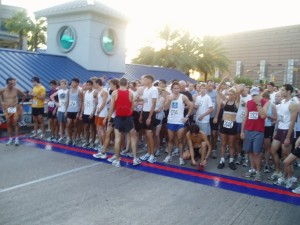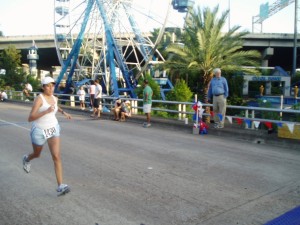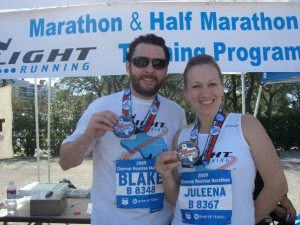 I love running and coaching runners but honestly one of my least favorite things is running short distance races like 5Ks. Why? Because they are painful, don’t give you too much room for error and are over in the blink of an eye compared to a marathon. I know it sounds crazy but give me a half marathon or marathon to run any day. Longer races allow you much more opportunities to screw up but make the necessary adjustments along the way to redeem yourself in the end.
I love running and coaching runners but honestly one of my least favorite things is running short distance races like 5Ks. Why? Because they are painful, don’t give you too much room for error and are over in the blink of an eye compared to a marathon. I know it sounds crazy but give me a half marathon or marathon to run any day. Longer races allow you much more opportunities to screw up but make the necessary adjustments along the way to redeem yourself in the end.
But you have to crawl before you walk, walk before you run and run 5Ks before you tackle marathons and half marathons. As a running coach I believe that racing is essential for building better runners. In a previous post I offered up some tips on Getting The Most Out Of Your Next 5K. After running a 5K the weekend after I wrote that post I realized I forgot a few things as I was rewinding how the race played out in my head. So here are a few more tips to help you reach that next PR. And remember, every race is a learning experience. So review your race in your head and set your mind on what you need to do the next time you hit the streets.
More 5K Fine Tuning Tips
Everyone wants to run faster or destroy that old 5K time. Here are a few more tips that may help you get a new PR (personal record) at your next race:
Invest In Some Racing Shoes – They Make A Difference!
I have raced for years and never tried running in racing shoes until my last 5K on July 4th. Racing shoes, sometimes called racing flats, are light weight running shoes with very little cushioning. These babies are built for speed and short distance racing and most shoe manufacturers carry a few models. Go to a running specialty store like Fleet Feet to find them as most sporting goods stores don’t carry them. They are a little pricey with most selling for $100 plus retail but well worth it. Only use them for race days and you will get your money’s worth. I highly recommend my racing shoe, the Brooks Racet ST 4.
Pull Back The Reigns & Smooth Your Pacing Out
One thing we try to instill in our runners is being very aware of their pacing whether it is a trying run or it really counts on the race course. We don’t coach negative splits (running the second half of a training run or race faster than the first). For beginner runners negative splits are a great way to blow up before you hit the finish line. If you can become a human stop watch as a runner and internally know your pace you will go far. Set a pace goal in your mind and try to nail it for miles 1 and 2. If you feel good, somewhat controlled breathing then build pace during mile 3. If your tank still has gas in it gun it at the end and take out a few runners ahead of you.
Did You Go Out Too Fast Or Too Slow The Last Time?
As I mentioned above most people let adrenalin sabotage their running by running way too fast out of the blocks. Take a look at your pacing from the last race, have a realistic goal and try to start with goal pace. If you had a lot left after the last race you may want to go out a little more agressive and see if you can hold it
Communicate With & Thank Water Station Volunteers
Your water stop strategy can be just as important as your pacing strategy regardless of the race distance. Many times the race brocure will not tell you how many water stops are available and when they are available. So before you pass up fluids at the first water stop always ask a volunteer what is ahead. That may be your only chance to take down fluids so you don’t want to pass it up if it is the only water stop. Also always thank volunteers for coming out and helping. With volunteers most of us would be toast during a 5K race.
Adjust For The Weather – It Will Affect Performance Big Time
If the weather is extremely hot, extremely cold or extremely windy don’t expect a PR. Your pace may suffer and you have to bring down pacing to adjust or extreme weather will beat you in the end. On hot days which we have more of in Houston runners should make a point of hydrating as soon as they get up out of bed. Also if it is hot take down water at least once. Slower runners who are on the course longer should probably take down water every chance they get. A cup of water poured over your head in hot weather may also be good idea.
Use The 30 Second Countdown When Things Get Rough
I learned this great tip from my run coaching business partner, Duval Ruiz, years ago and it still works like a charm. When the race gets tough and you have to press on break up the race in 30 second chunks but counting in 30 second intervals in your head. Count one one thousand, two one thousand, etc. until you hit 30. Then reset and count out another set of 30. You will be amazed how this will take your mind off the race or the pain you are enduring at the end. This is a great tool to keep moving forward when you would normally slow down or throw in the towel.
Now go out there and bust it! Hope your next race is a personal best.



